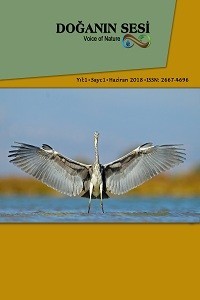SALDA GÖLÜ’NDE BİOMİNERALİZASYON VE STROMATOLİT OLUŞUMU
Yeryüzündeki ekosistemlerde canlı ve cansız öğeler, enerji akımı, kimyasal döngüler ve popülasyon denetimleri gibi üç temel işlevle birbirine bağlanmakta ve bu üç işlev ekosistemlerin niceliksel olarak çalışabilmesi için gerekli temeli oluşturmaktadır.
Mineralizasyon olayı, doğada kendiliğinden meydana gelen biyolojik ve kimyasal olaylardır. biyomineralizasyon olayı ise mineralleşme olarak belirtilmekte ve özellikle Prokaryot (bakteriler, mavi-yeşil algler) canlılar tarafından gerçekleştirilmektedir. Biyomineralizasyon gerçekleştiği su ekosisteminin özelliklerine göre faklı oluşumlara neden olmaktadır. Buna göre Salda Gölü’nün jeolojik oluşumu, jeolojik fosil kayaç dokusu, kretase kireçtaşları, çevresi, biyolojik çeşitliliği, iklimi, gölün ve göle ulaşan suların kalitesi, özellikle göl suyunun alkalinitesi (pH 9.2-9.4) gibi ekolojik yapı reaksiyonların oluşmasında biyomineralizasyon önem arz etmektedir. Salda Gölü’ndeki biyomineralizasyonu gerçekleştiren; yeryüzünün en eski ve ilkel canlıları olup, enerji kaynağı olarak güneşi kullanan fotosentez yoluyla kendi besinini ve ortamın oksijenini üretebilen Chroococcus sp. Cyanobacteria (mavi-yeşil algler) grubuna ait türlerdir.
Salda Gölü’nde mavi-yeşil alglerin yüzeye yapışarak kümelenmesi sonucunda oluşan biyofilmlerinin tortu tanelerinin bir araya gelip birikmesi ve donması ile sığ sularda oluşan, genişleme eğilimli katmanlı yapılar olan manyezitli stromatolitlerin oluşmasını sağlamaktadır.
Bu çalışmada daha önceki araştırmalar doğrultusunda, literatür çalışmalarının da katkısıyla Salda Gölü’ndeki sulu manyezit oluşumunun dünyadaki benzer özelliklerini taşıdığı bildirilen Kanada’daki Alchichica Gölü’ndeki biyomineralizasyon sonucu oluşan stromatolit oluşumlarının gerçekleştiği çökellerle karşılaştırılması da amaçlanmıştır.
Anahtar Kelimeler:
Salda Gölü, biomineralizasyon, stromatolit
Biomineralization and Stromatolite Creation in Lake Salda
In the ecosystems on earth, living and inanimate elements are linked by three basic functions such as energy flow, chemical cycles and population controls, and these three functions form the basis for the ecosystems to work quantitatively. The mineralization event is biological and chemical events that occur spontaneously in nature.
The biomineralizasyon event is specified as mineralization and is carried out especially by Prokaryota (bacteria, blue-green algae) living things. Depending on the characteristics of the ecosystem, biomineralizasyon water causes different formations. Accordingly, the geological formation of the Salda Lake – geological fossil rock texture – Cretaceous limestones – its environment, biological diversity, climate, the lake – the quality of the waters reaching the lake, especially the alkalinity of the lake water (pH 9.2 – 9.4), etc. ecological structure is important in the formation of reactions. Performing bio-mineralization in Salda Lake; They are the oldest-primitive creatures on earth and are Chroococcus species Cyanobacteria, which can produce their own food and the oxygen of the environment through photosynthesis, which uses the sun as an energy source.
In Lake Salda; The oldest and primitive creatures of the world, blue-green algae – Cyanobacteria-biofilms (a cluster of microorganisms to which they stick to the surface) enable the formation of magnesite stromatolites, which are layered structures that tend to expand, form in shallow waters and tend to expand.
In this study, in line with our previous researches, it is aimed to compare with the sediments in which bioma- mineralization formed as a result of bio-mineralization in Alchichica Lake (Canada), which is reported to have similar properties in the world, with the contribution of the literature studies.
Keywords:
Lake Salda, biomineralization, stromatolite,
___
- Arp, G., Reimer, A., and Reitner, J. (1999). “Calcification in cyanobacterial biofilms of alkaline salt lakes”. European Journal of Phycology, 34, (393-403).
- Awramik, S.M., and Grey, K. (2005). “Stromatolites: biogenicity, biosignatures, and bioconfusion”. Proceedings of SPIE, 5906, 5906P-1- 5906P-9.
- Balcı, N., Menekşe, M., Karagüler, N.G., Sönmez, M.Ş., and Meister, P. (2016). “Reproducing authigenic carbonate precipitation in the hypersaline Lake Acıgöl (Turkey) with microbial cultures”. Geomicrobiology Journal, 33 (9), (758-773).
- Balcı, N.- Demirel, C., Kurt, M.A. (2018). “Geomicrobiology of Lake Salda and Microbial Influences on Present-Day Stromatolite Formation”. Bulletin of the Earth Sciences Application and Research Centre of Hacettepe University 39 , 1, (19–40)
- Gérard, E., Pearce, C.R. and Oelkers, E.H. (2013). “Using Mg Isotopes to Trace Cyanobacterially Mediated Magnesium Carbonate Precipitation in Alkaline Lakes”. Aquatic Geochemistry Vol.19, Nr.1, (1-24) ISBN 1 573-1 421
- Gülle, İ. (2011). “Burdur, Salda ve Acı Göl’ün fitoplanktonik ve trofik özelliklerinin incelenmesi”. Mehmet Akif Ersoy Üni. Bilimsel Araştırma Prj.0010-NAP-07.
- Hammes.,F. Verstraete (2002). “Key roles of pH and calcium metabolism in microbial carbonate precipitation Reviews in Environmental Science and Biotechnology” . Volume 1, pages 3–7
- Kamennaya, N. A., Ajo-Franklin, C. M., Northen, T. Ve Jansson, C. (2012) “Cyanobacteria as biocatalysts for carbonate mineralization”. Minerals, 2(4), 338-36
- Kazanci, N., Girgin, S., and Dügel, M. (2004). “On the limnology of Salda Lake, a large and deep soda lake in southwestern Turkey: future management proposals, aquatic conservation. Aquatic Conservation: Marine and Freshwater Ecosystems”. 14, 151–162.
- Kaźmierczak,J., Kempe,S., Kremer,B., Garcia, L., Moreira, D. (2011). “Hydrochemistry and microbialites of the alkaline crater lake Alchichica”. Mexico. Springer Link volüme 57, (543–57)
- Kesici, E., Kesici, K., Kesici, C. (2018); Salda Gölü korunan alanın sürdürülebilirliği. (Sustainability of Salda Lake Protected Area). Doğanın Sesi yıl 1, sayı 1-14 Sudaki Yaşam (3-11).
- Kesici, E. (2010). “Burdur Valiliği İl Çevre ve Orman Müdürlüğünün Burdur Gölü Yönetim Planı (2008-2012) kitabı ile ilgili rapor”, SDÜ Eğirdir Su Ürünleri Fakültesi, Eğirdir
- Komarek,J. (1996). “Meksika, Puebla Eyaleti, Alchichica volkanik gölündeki siyanoprokaryotlar”. 117, com; 511-538.
- OSİB (2013). “Salda Gölü Sulak Alan Alt Havzası Biyolojik Çeşitlilik Araştırması”, s.179
- OSİB (2017). “Göller ve Sulakalanlar Eylem Planı 2017-2023
- Tavera, R. / Russel, M.J., Ingham, J.K., Zedef, V., Maktav, D., Sunar, F., Hall, A.J., and Fallick, A.E. (1999). “Search for sings of ancient life on Mars: expectations from hydromagnesite microbialites, Salda Lake, Turkey”. Journal of the Geological Society, 156 (869-888)
- Wikipedia ; Kalsiyum Karbonat -Chlorophyta- Chroococcus (18.06.2020)
- Wetzel, R. G. (2001).“Limnology: Lake and River Ecosystems”,Third Edition, Academic Press 1006pp.
- Yayın Aralığı: Yılda 2 Sayı
- Başlangıç: 2018
- Yayıncı: Doğa ve Sürdürülebilirlik Derneği
